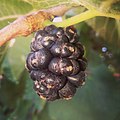Morus nigra
| Black mulberry | |
|---|---|

| |
| Plate from book: Flora of Germany, Austria, and Switzerland (1885) | |
| Scientific classification | |
| Kingdom: | Plantae |
| Clade: | Tracheophytes |
| Clade: | Angiosperms |
| Clade: | Eudicots |
| Clade: | Rosids |
| Order: | Rosales |
| Family: | Moraceae |
| Genus: | Morus |
| Species: | M. nigra
|
| Binomial name | |
| Morus nigra | |
| Nutritional value per 100 g (3.5 oz) | |
|---|---|
| Energy | 180 kJ (43 kcal) |
9.8 g | |
| Sugars | 8.1 |
| Dietary fiber | 1.7 g |
0.39 g | |
| Saturated | 0.27 g |
| Monounsaturated | 0.041 g |
| Polyunsaturated | 0.207 g |
1.44 g | |
Niacin (B3) | 4% 0.62 mg |
| Vitamin B6 | 3% 0.05 mg |
| Folate (B9) | 2% 6 μg |
| Choline | 2% 12.3 mg |
| Vitamin C | 40% 36.4 mg |
| Vitamin E | 6% 0.87 mg |
| Vitamin K | 7% 7.8 μg |
| Minerals | Quantity %DV† |
| Calcium | 3% 39 mg |
| Iron | 10% 1.85 mg |
| Magnesium | 4% 18 mg |
| Phosphorus | 3% 38 mg |
| Potassium | 6% 194 mg |
| Sodium | 0% 10 mg |
| Zinc | 1% 0.12 mg |
| †Percentages estimated using US recommendations for adults,[1] except for potassium, which is estimated based on expert recommendation from the National Academies.[2] | |
Morus nigra, called black mulberry
Description
Morus nigra is a
The fruit is a compound cluster of several small drupes that are dark purple, almost black when ripe, and they are 2.5 cm (1 in) in diameter.[7] Black mulberry is richly flavoured, similar to the red mulberry (Morus rubra) rather than the more insipid fruit of the white mulberry (Morus alba). Mulberry fruit color derives from anthocyanins.[8]
Sometimes other
Cultivation and uses
Black mulberries (Morus nigra) are thought to have originated in the mountainous areas of Mesopotamia and Persia (i.e. Armenian highlands). Black mulberry is planted, and often naturalised, west across much of Europe, including Ukraine, and east into China. Now they are widespread throughout Armenia, Afghanistan, Iraq, Iran, India, Pakistan, Syria, Lebanon, Jordan, Palestine, Israel, and Turkey.
The fruit is edible
In Europe, the largest-documented local concentration of black mulberries may be found in the vineyards of Pukanec in Slovakia,[10] which contain 470 black mulberry trees.
The black mulberry was imported into Britain in the 17th century in the hope that it would be useful in the cultivation of silkworms (
Gallery
-
Leaf of Morus nigra
-
Ripe fruit and foliage of Morus nigra
-
A centuries-old tree of Morus nigra
-
Female flowers of Morus nigra
-
An old black mulberry tree in spring
-
Unripe shahtoot (Iran)
-
Full-grown shahtoot
-
From Algeria Morus nigra
References
- ^ United States Food and Drug Administration (2024). "Daily Value on the Nutrition and Supplement Facts Labels". Retrieved 2024-03-28.
- )
- ^ "Morus nigra". Germplasm Resources Information Network. Agricultural Research Service, United States Department of Agriculture. Retrieved 21 December 2017.
- ^ "Definition And Classification Of Commodities (Draft) 8. Fruits And Derived Products". Food and Agriculture Organization of the United Nations. Retrieved 1 August 2014.
- ISBN 978-1405332965.
- PMID 26266951.
- ^ a b "Morus nigra Black Mulberry PFAF Plant Database". Plants for a Future. Retrieved 2022-05-15.
- ^ James A. Duke (1983). "Morus alba L., Moraceae: White mulberry, Russian mulberry, Silkworm mulberry, Moral blanco". Handbook of Energy Crops. Archived from the original on 2012-10-28. Retrieved 8 March 2020.
- ISBN 9781400852994.
- ISBN 9781489976628.








